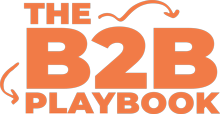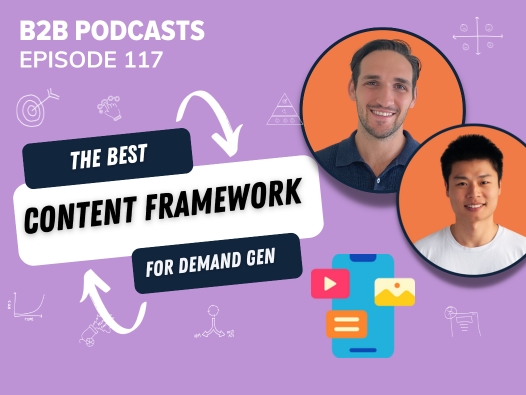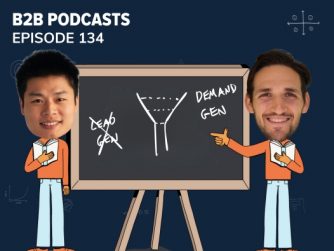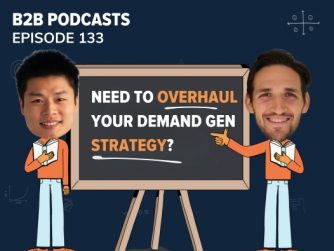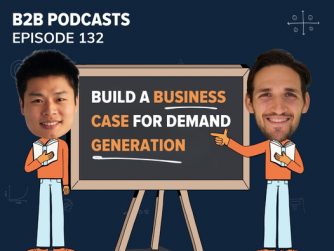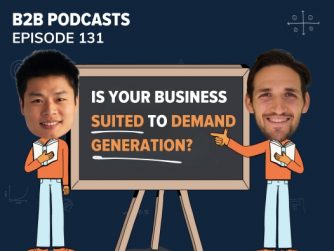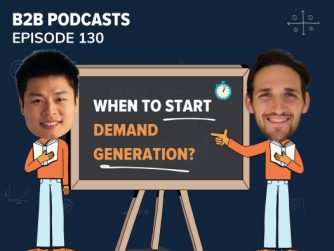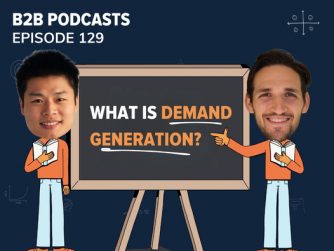One of the greatest challenges that so many Demand Gen B2B marketers face when I speak to them is content, and creating content that has a meaningful impact on the business. Now, meaningful impact doesn’t mean “bringing more website visitors” through SEO. It means the content helps your potential customer along their own buying journey. That’s the kind of content that helps drive pipeline and revenue for the business.
Listen To The Episode
Watch The Episode
It’s the kind of content you need holds the prospect’s hand, leading them from being unaware that they even have a problem that you can solve, to leading them to the logical conclusion that you’re the perfect business to do it. The content framework that we’ve had the most success with from a demand generation perspective is Eugene Schwartz’, ‘The 5 Stages of Awareness‘, taken from his copywriting classic “Breakthrough Advertising”.
So today I’m going to share this content framework with you, and walk you through how you can apply it practically. We’ll also share our own learnings from years of applying the framework so you can get the most out of it from the beginning.
But before we get into the framework, I think it’s important that we first define demand generation so we can understand why they fit together so well.
What Is Demand Generation?
Demand generation is a go-to-market strategy that really builds a very intense desire in your dream customer to purchase from your company. It’s comprised of two parts: demand capture and demand creation. Demand capture is about targeting the 3% of the market ready to buy now, while demand creation focuses on the remaining 97% who are not actively seeking a solution.
“Demand generation is a go-to-market strategy that really builds a very intense desire in your dream customer to purchase from your company.”
George Coudounaris – [00:10:15]
The 5 Stages of Awareness framework means you will create content to both create and capture demand. It covers the whole funnel, which is why it’s so effective in building demand.
Why The 5 Stages of Awareness are so Effective in Demand Gen
Each stage aligns with the natural progression of customer awareness, allowing marketers to tailor their strategies to the customer’s current mindset. By creating content for and addressing each stage, you’re not just capturing existing demand but creating and nurturing it. This method builds a deeper connection with the audience, gradually steering them towards your solution, making it a natural choice when they’re ready to purchase.
The Five Stages of Awareness: A Roadmap to Demand Gen Mastery
Now let’s get into what each of the 5 Stages of Awareness are:
- Unaware: At this stage, potential customers are not even aware that they have a problem or a need that your product or service can address.
- By volume they’re the largest segment, but also the most challenging to market to
- Problem Aware: Here, customers realize they have a problem but may not know the solutions available.
- They have lots of questions here at this point
- Solution Aware: Customers are aware of various solutions to their problem but may not be familiar with your specific product or service.
- They don’t know about you or what you offer, but they want to sort out the problem
- Product Aware: In this stage, customers know about your product or service but are still comparing it with other options in the market.
- Your prospect is now looking at all options, including yours
- Most Aware: Finally, customers are fully aware of your product, including its benefits and how it compares to competitors. They are on the brink of making a purchase decision.
- They need a final nudge to pull out the credit card
Implementing the Framework
When implementing this framework in practice, it can feel overwhelming deciding where to start. My advice is to start with content that addresses the later stages of awareness, serving immediate business needs and aiding sales.
Content created in the later stages of awareness is likely to be material that sales are already asking you for. This includes things like case studies, competitor comparisons, product information, peer reviews and more.
Once that is completed, start to work your way up the stages of awareness.
Balancing Emotion and Logic in The 5 Stages of Awareness
I also recommend that when you write your content, in the earlier stages your content should focus on ‘loss aversion’. Loss aversion means that humans feel the pain of losing twice as powerfully as the pleasure of gaining. So when we try and shift someone from an ‘unaware’ to a ‘problem aware’ state, we need to highlight the pain and what they’re losing out on by not addressing this problem.
Your job at this stage is to identify the pain the prospect is feeling, and twist the knife in until they prioritise it.
Once they start exploring solutions however, you can start leading them away from pain and towards please. Show them the Dream State that they can achieve by solving their problems.
Content should balance emotional engagement with logical, thoughtful information, especially as prospects progress through their journey.
Kevin and I give detailed examples of this throughout the episode.
Building Trust and Relationships
The beauty of this content framework is that it builds trust with your Dream Customer. You have the opportunity to be top of mind and forge a relationship with them, well before they’re ready to buy a product.
And remember, the essence of Demand Generation is in building trust.
“By guiding them through each stage… That creates trust between you and your dream customer”
George Coudounaris – [00:35:50]
Trust is essential in B2B marketing. It’s what makes a potential customer pick your brand over a competitor.
Conclusion: The Demand Gen Framework Philosophy
The Demand Gen Framework is a philosophy that places the customer’s journey at the centre. It’s about being helpful and understanding their journey stage, guiding them towards your solution. The 5 Stages of Awareness allows your potential customers to navigate their journey in a natural way, and leads them to the obvious conclusion that you’re the best fit for them. That’s why its our favourite content framework to use.
Create Your Demand Engine in 12 Weeks
B2B marketing strategy that shows you step-by-step how to drive revenue
